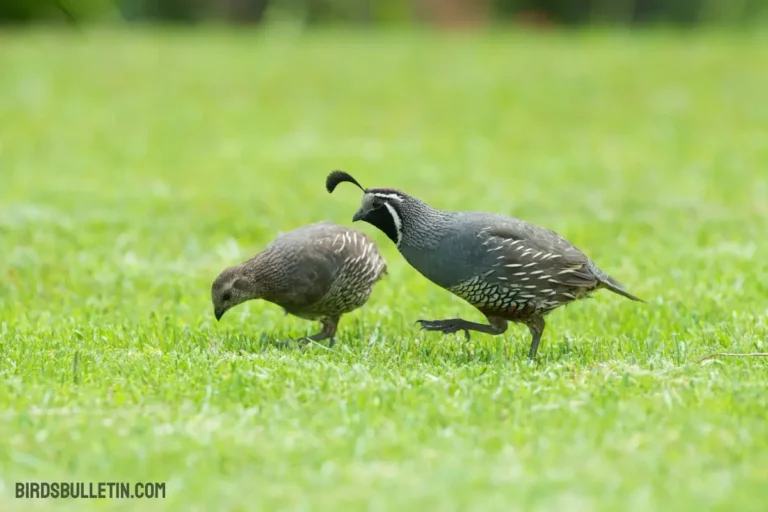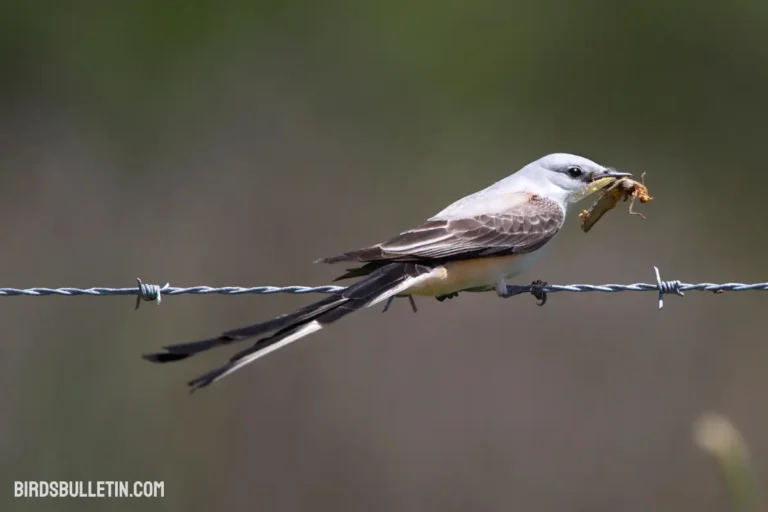What Does the Ruffed Grouse Eat?
With its ruffly black ruffs and banded tail feathers, the aptly named ruffed grouse cuts a striking profile as it struts through woodland understory searching out sustenance. These chicken-like upland game birds dwell in young forests across much of North America.
But thriving grouse numbers depend heavily on the availability of diverse woody vegetation and fruits interspersed with ample protein-rich insects to fuel fast growth and winter survival. Ruffed grouse chicks eat nearly their entire body weight daily in the first week alone.
This rapid development allows precocial young to feed themselves quickly. But cold months prove more challenging for juveniles and adults alike when insect fare grows scarce among the leaf litter. Fortunately, ruffed grouse adapt their diet seasonally to take advantage of nature’s shifting bounty.
Looking for more articles about birds’ food and diet
Favorite Ruffed Grouse Foods
Ruffed grouse feed mostly on the ground, scratching through litter seeking nourishment. But they also perch to browse leafy greens and fruits. Favored foods by season include:
| Food Item | Details |
|---|---|
| Insects | Beetles, ants, larvae, and flies allow chick growth and year-round protein. |
| Green Vegetation | Consume leaves, flowers, shoots, and buds April-November. |
| Fruits and Seeds | Favor winter staples like rose hips, chokecherries, dogwood, sumac, and wild grapes. Also eat various seeds, acorns, and conifer needles. |
How Often Ruffed Grouse Eat?
Chicks less than a week old eat virtually nonstop, needing huge volumes to fuel ultra-fast growth. By two months old their intake plateaus to adult levels, then declines again in winter when metabolism slows and food grows scarce.

Adults feed in frequent small meals year-round except for brief fasts during peak breeding.
What Time of Day Is Ruffed Grouse Feed?
Most active periods are early morning and late afternoon traveling between foraging and dust bathing sites. But ruffed grouse sporadically feed all day with brief pauses for preening, dusting, and resting while still keeping alert.
If conditions allow, they continue browsing on warm afternoons or scratching below winter snowpack seeking sustenance.
How Ruffed Grouse Gathers Food?
Ruffed Grouse are primarily ground-dwelling birds that forage for food on the forest floor. Their diet consists of a variety of plant materials, insects, and small invertebrates. Here are some ways Ruffed Grouse gather food:
01. Ground Foraging:
Ruffed Grouse spends a significant amount of time on the forest floor, scratching and pecking at the ground to uncover food. They use their strong legs and feet to scratch away leaves and debris, exposing seeds, insects, and other edible items.
02. Eating Vegetation:
Ruffed Grouse consumes a variety of plant materials, including buds, leaves, fruits, and seeds. In the spring and summer, they focus more on tender vegetation.
03. Insect Consumption:
Insects and other invertebrates are an important part of the Ruffed Grouse diet, especially during the summer months. Grouse catch insects on the ground or glean them from vegetation.
04. Browsing in Trees:
While Ruffed Grouse are primarily ground foragers, they also perch in trees to reach buds and catkins. They have specialized crops that allow them to store and digest food efficiently.
05. Seasonal Variations:
Ruffed Grouse adapt their diet to the seasons. In winter, with scarce vegetation, they rely on buds, twigs, and seeds. In warmer months, they diversify their diet with insects and fresh plant material.
Ruffed Grouse are adapted to live in forested areas and have evolved feeding behaviors that suit their environment.
What Ruffed Grouse Eat in Winter?
Winter diet relies more heavily on tree buds, conifer needles, seeds, and persistent fruits when insects prove hard to access beneath snow or frozen soil.
Fortunately, they are able to digest fibers allowing tree browsing. Conserving energy also becomes a priority during frigid temperatures and storms.
What Baby Ruffed Grouse Eat?
Female leads precocial fuzzy chicks to protein-rich insect sources right after hatching. Initially, the hen shows available prey but by day two chicks can capture their own insects and leaves.
Baby Ruffed Grouse primarily consumes a diet rich in insects. Their diet typically includes a variety of small invertebrates such as insects, larvae, and spiders.
Aside from insects, young Ruffed Grouse also eat tender plant shoots, seeds, and berries. As they mature, their diet broadens to encompass a wider array of foods, aligning with the feeding habits of adult Ruffed Grouse.
Frequently Asked Questions
01. How many kinds of vegetation do ruffed grouse consume?
Research shows ruffed grouse eat 98 different species of native trees, shrubs, and plants across their range. Diet diversity provides optimal nutrition.
02. Why are they important to forest renewal?
Dense early successional habitat supports grouse best. And their browsing stimulates new growth while droppings aid reforestation.
03. How does their winter diet differ by region?
Northern populations rely more on conifer needles and tree buds while southerly grouse switch to nuts and fruit swapping some evergreens deciduous fare.
Conclusion
The ruffed grouse is well equipped to exploit wooded habitats across Canada and the northern United States thanks to a flexible diet centered around vegetation readily available throughout the year – given appropriate forest management.
Abundant flowers, fruits, seeds, and insects in younger woodlands allow successful reproduction and chick survival to sustain populations of this popular game bird long into the future.
References
- Bergerud, A. T., & Gratson, M. W. (1988). Survival and breeding strategies of grouse. Adaptive strategies and population ecology of northern grouse, 573-577.
- Rusch, D. H., Destefano, S., Reynolds, M. C., & Lauten, D. (2000). Ruffed Grouse (Bonasa umbellus), version 2.0. In Birds of the World (A. F. Poole and F. B. Gill, Editors). Cornell Lab of Ornithology, Ithaca, New York, USA.
- Zimmerman, G. S., Gilmore, D. W., & Sillett, S. C. (2007). Habitat occupancy by Ruffed Grouse Bonasa umbellus in managed forests of Minnesota, USA. Wildlife Biology, 13(4), 379-393.







